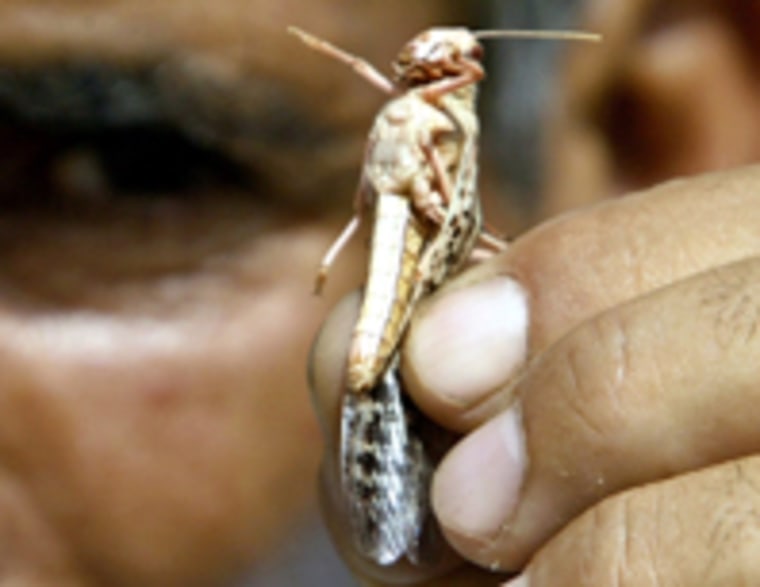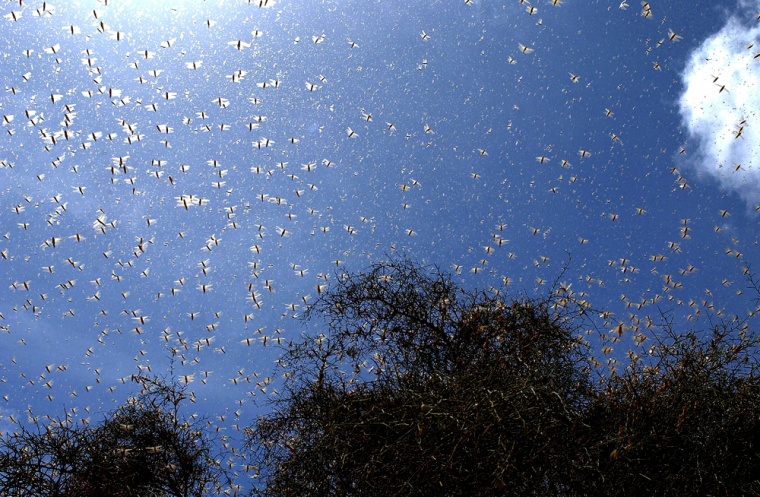Clouds of locusts swarmed this West African city on Thursday, crunching underfoot, blurring people’s vision and causing traffic accidents as sub-Sahara’s biggest plague of the insects in more than a decade swept south from the desert.
Burning smoky bonfires of tires and trash, the people of Nouakchott tried to fight back the onslaught of the crop-eating bugs — estimated by the U.N. Food and Agriculture Organization to be moving as fast as 60 miles a day and settling at a rate 200,000 locusts per acre. Blankets of the insects covered houses, cars and roads.
“It’s beautiful to see and funny, the locusts on parade in the sky,” marveled Aicha Bint Sadibouh, a woman in Noaukchott. “But when they invade the streets and homes, it’s disastrous.”
‘Difficult summer’ for farmers
The locusts’ descent on a major sub-Saharan city made vivid a growing international warning: Unseasonably heavy rains up north had spawned the northwest Sahara’s largest locust population since 1988.
Experts warned of threats to vital rainy-season planting now and harvests later. They urged urgent international action for an arid, hardworking region already perpetually on the edge of food shortages.
“Farmers are just now planting the seeds in the ground ... some farmers now are afraid to plant any more seeds — they’re afraid once seeds germinate and the little plants come up, they will be attacked by the locusts,” said Keith Cressman, a locust forecast officer with the Rome-based U.N. agency.
“The last risk is that when the crops are ready to be harvested, around September, that will coincide with the formation of new swarms” from eggs being laid now, Cressman said. “That harvest could be seriously disrupted,” making for a “very difficult summer” for farmers.
At risk are sustenance crops of millet, sorghum and other grains that feed millions of people in vulnerable Saharan states. Vegetable crops for markets likewise were in danger.
Smoking them out
The locust swarms hit the Mauritanian capital Wednesday, making good on weeks of warnings from African leaders and international agencies. Overnight, the desert city’s people burned tires, garbage and whatever else they could spare, hoping the acrid smoke would repel the insects.
“My father caused a traffic accident at the main intersection near the capital market because locusts took visibility down to almost nothing,” said Veliha mint Baba, a recent university graduate.

The last comparable locust infestation, in 1987-89, cost more than a half-billion dollars to combat. About half that came from international donors, Cressman said.
This time, aircraft, pesticides, vehicles, sprayers and technical support are needed in the nine threatened countries. So far, donors including the European Community, Italy, Norway, North Korea, Spain, the United States and the FAO had provided about $9 million, the U.N. agriculture agency said.
Another $10 million was in the pipeline, but up to $83 million was needed, the FAO said.
The president of Mauritania’s southern neighbor, Senegal, canceled a foreign trip in recent days to deal with the locusts in the far eastern part of his country. Senegal’s neighbor Gambia declared a state of emergency. The insects are spreading through Mauritania, Mali and Niger, and U.N. experts said Chad and the western Sudan region of Darfur were at risk.
Those regions are already suffering what international observers call the world’s worst humanitarian crisis from a campaign of violence by government-backed Sudanese militias against non-Arab African villagers.
